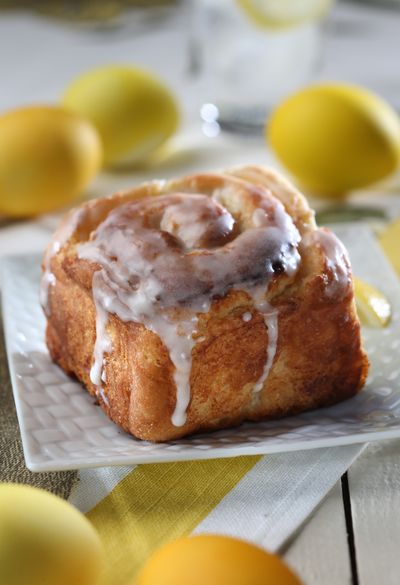Advance-prep sweet rolls make holiday breakfast festive

There’s a reason fresh-baked sweet yeast breads are beloved. The fresh-from-the-oven aroma is comforting and a warm roll filled with a sweet filling is a superb way to start a special day.
Perhaps that’s why the Easter season features an abundance of traditional yeast breads, from plump Polish paczki devoured a day before Lent and those hot cross buns baked for Good Friday on to the varied Easter breads of Italy, Greece, Portugal and others. Often decorated with tinted eggs or colorful sugar sprinkles, they are rich with symbolism.
You need not have a traditional family recipe to bring a sweet yeast bread to the Easter breakfast table. Nor need you fear yeast dough with this simple recipe that can be mixed and shaped the day before, chilled overnight then baked Easter morning.
Tips on yeast doughs
Mix yeast into warm-to-the-touch water (about 100 degrees). Add a tiny pinch of sugar to feed the yeast. Let mixture stand several minutes. It should bubble and foam slightly. If it doesn’t and the yeast is fresh, the water may have been too hot or too cool; discard and repeat with new yeast.
You’ve never kneaded dough? Slightly flatten dough then lift the side of the dough furthest from you and fold toward you. Use the heels of your hands to push the folded edge down and away from you. Turn dough a quarter turn and repeat several times.
Do not let dough proof (rise) too much once removed from the refrigerator; dough will continue to rise during baking.
Sweet Rolls as You Like ’Em
We developed this versatile recipe based on a sweet dough from “The Fleischmann Treasury of Yeast Baking,” a booklet produced in 1962. Mix and shape rolls the night before you plan to serve them, using one of our three fillings or one of your own. Then bake in the morning.
1/2 cup each: milk, granulated sugar
1/2 stick (4 tablespoons) unsalted butter
1 1/2 teaspoons salt
2 packages ( 1/4 ounce each) active dry yeast
1/2 cup warm water (100-110 degrees Fahrenheit)
5 cups flour, lightly spooned into a measuring cup
2 eggs, lightly beaten
1/2 stick (4 tablespoons) unsalted butter, melted
Filling and icing: see recipes below
Heat milk to a simmer in a small saucepan; stir in sugar, butter and salt. Pour into a mixing bowl; cool to lukewarm. Sprinkle yeast into warm water; stir until dissolved. Mixture should bubble up after a few minutes.
Set aside 1/2 cup flour for kneading. With a sturdy wooden spoon, stir eggs, yeast mixture and half the remaining flour into the lukewarm milk mixture until smooth. Add remaining flour, beating well with a wooden spoon until dough pulls away from the sides of the bowl. You should have a somewhat stiff dough. Turn dough onto a lightly floured surface. Dust hands lightly with flour; shape dough into a ball. Flatten slightly then knead several minutes until smooth and elastic; it should bounce back when gently pressed with a finger. Dust top lightly with flour; cover with a clean cloth and let rest, 15 minutes.
While dough rests, line a 13-by-9-inch baking pan with two pieces of aluminum foil, one crosswise, one lengthwise; leave ends loose to make removing the baked rolls from pan easier. Brush foil well with some of the melted butter. Prepare a filling.
Pat down dough; roll into a 12-by-18-inch rectangle. Brush lightly with melted butter. Sprinkle or spread with filling of your choice, leaving a 1/2-inch space along the edges. Starting from long side nearest you, roll dough up tightly; pinch long seam closed. Cut roll into 1 1/2-inch slices using a sharp knife. Or use a 12-inch piece of sturdy thread to cut slices: Place thread under roll at a 1 1/2-inch mark. Pick up thread ends – thread on the right with your left hand, thread on the left with your right hand – and pull thread ends across roll to cut. You should have 12 rolls. Arrange cut rolls in prepared baking pan, leaving space between them. Brush tops with remaining melted butter. Cover pan with plastic wrap; refrigerate overnight.
Remove rolls from refrigerator; carefully remove plastic wrap. Heat oven to 375 degrees. Let rolls stand at room temperature, 15 to 20 minutes. (Do not let them get too puffy before baking.) Bake until tops are nicely browned, 25 to 30 minutes. Cool in pan on a rack, 5 minutes. Use ends of foil as handles to remove rolls from pan. Remove rolls from the foil, with help from a spatula. Place on a serving tray; cool 10 minutes. Drizzle with icing before serving.
Nutrition information per roll (with pecan-raisin filling): 425 calories, 13 grams fat, 6 grams saturated fat, 52 milligrams cholesterol, 72 grams carbohydrates, 7 grams protein, 312 milligrams sodium, 3 grams fiber.
Yield: 12
Fillings
Adapted from “The King Arthur 200th Anniversary Cookbook”
Cinnamon-pecan- raisin: Mix 3/4 cup granulated sugar with 1 1/2 tablespoons ground cinnamon. Mix in 1/2 cup chopped pecans and 1/2 cup raisins or dried cranberries.
Fig-walnut: Spread about 1 cup (about an 8.5-ounce jar) fig preserves on dough; sprinkle with 1/2 cup chopped walnuts.
Lemon-cheese: Blend 12 ounces cream cheese with 3 tablespoons granulated sugar, 1/4 teaspoon salt, 1 egg yolk and 1 tablespoon each finely grated lemon zest and lemon juice.
Icing
Blend 1 1/2 cups confectioner’s sugar, 2 tablespoons milk and 1/2 teaspoon vanilla in a small bowl with a whisk; add more milk if needed to drizzle.